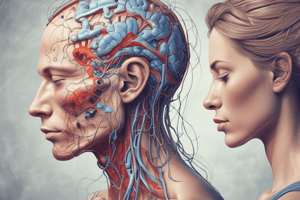Podcast
Questions and Answers
What is the common cause of deafferentation leading to pain?
What is the common cause of deafferentation leading to pain?
- Chronic inflammation
- Infection of the tooth
- Trauma or surgery (correct)
- Neurodegenerative disease
What is the effect of local anesthetic block on pain in cases of CNS hyperactivity?
What is the effect of local anesthetic block on pain in cases of CNS hyperactivity?
- It reduces the pain but does not eliminate it
- It increases the pain
- It arrests the pain
- It has no effect on the pain (correct)
What is the mechanism underlying peripheral hyperactivity leading to pain?
What is the mechanism underlying peripheral hyperactivity leading to pain?
- Inflammation of the nerve tissue
- Neuronal hyperactivity at the site of nerve damage (correct)
- Demyelination of the nerve fibers
- Changes in the CNS lead to changes in the peripheral nerve
What is the role of the trigeminal nucleus in the development of pain due to deafferentation?
What is the role of the trigeminal nucleus in the development of pain due to deafferentation?
What is the characteristic of pain experienced in deafferentation due to CNS hyperactivity?
What is the characteristic of pain experienced in deafferentation due to CNS hyperactivity?
What is the similarity between phantom limb pain and oral deafferentation pain?
What is the similarity between phantom limb pain and oral deafferentation pain?
What is a characteristic of deafferentation pains in relation to peripheral surgical procedures?
What is a characteristic of deafferentation pains in relation to peripheral surgical procedures?
What percentage of persons will have had a bout of shingles by age 85 years?
What percentage of persons will have had a bout of shingles by age 85 years?
What is the primary key to recognizing conditions like deafferentation pains and avoiding unnecessary dental treatment?
What is the primary key to recognizing conditions like deafferentation pains and avoiding unnecessary dental treatment?
What is the approximate percentage of patients who will develop postherpetic neuralgia (PHN) after an episode of shingles?
What is the approximate percentage of patients who will develop postherpetic neuralgia (PHN) after an episode of shingles?
What is the role of the sympathetic nervous system in neuropathic pain processes?
What is the role of the sympathetic nervous system in neuropathic pain processes?
What is the typical age range for the onset of shingles?
What is the typical age range for the onset of shingles?
Flashcards are hidden until you start studying




